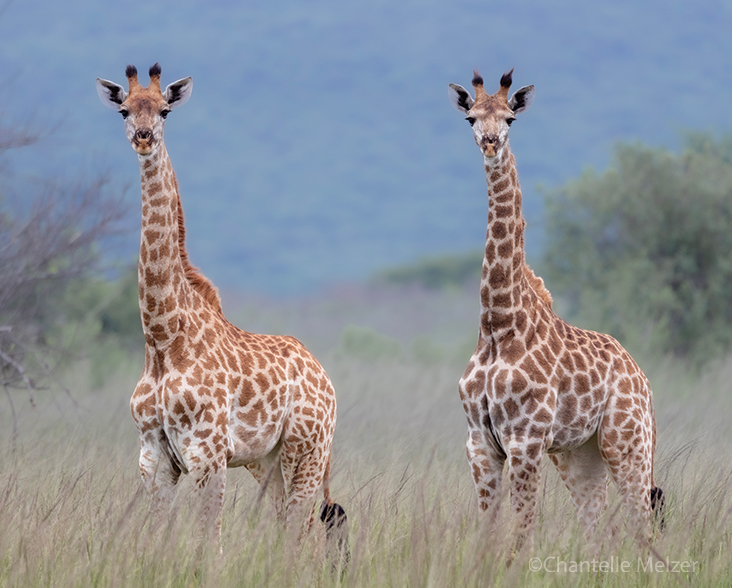Giraffe
Species Data
Class: Mammalia
Order: Artiodactyla
Family: Giraffidae
Scientific Name: Giraffa camelopardalis
IUCN Red List status: Vulnerable
Description
The world’s tallest animal, male Giraffes, or bulls, measure up to 5.7 m in height to the top of the head and weigh up to 1,930 kg. Females, or cows, are shorter and lighter, reaching up to 5 m to the top of the head and weighing up to 1,180 kg. With their large size, very long neck (made up of seven elongated vertebrae), long legs, sloping back from the shoulders to the rump, and variable pattern of irregular chestnut to dark brown patches separated by a network of light buff lines, the Giraffe is unmistakable.
Both sexes have a pair of short, skin and fur-covered frontal horns, bone protuberances called ossicones, on the top of the head between the ears, and often a median horn or knob, on the forehead between the eyes. The horns are thinner and smaller in females, and males sometimes also have a pair of very small horn-like protuberances on the back of the head. A short, stiff, chestnut-coloured mane runs along the back of the neck to the shoulders, and the long, thin tail, up to 101 cm, terminates with a blackish tuft. The underparts are whitish with faint spots, and the feet have two hoofed digits. The eyes are large, and the long black tongue reaches 46 cm long.
Newborn calves weigh 50 to 55 kg and are 2 m tall from the ground to the shoulders. Males reach sexual maturity at 4-5 years, and females at 3-4 years. In the wild, Giraffes typically live for 10-15 years.
Nine subspecies of Giraffes have been identified; however, a genetic study published in 2016 recognised four species of Giraffes.
Behaviour
Giraffes are gregarious, typically living in loose herds of 10-20 individuals, sometimes as few as 2-3, and occasionally up to 70. Herds can be single-sex, consist of a cow with young calves, or mixed-sex and ages, usually led by a female. Solitary individuals also occur, especially old bulls. Home ranges vary in size from 5-654 km² (1.9-253 mi²), according to the availability of food and water.
This species is not territorial, but adult bulls establish dominance by sparring, which involves two bulls firstly standing parallel and pushing against each other to gauge the other’s strength, then necking—lowering and swinging their head and neck to strike heavy blows with their horns to their opponent’s rump, flanks, legs, neck, and belly. These battles can be brutal and frequently cause injury. Sparring takes place year-round, and mock fights are frequent.
Feeding takes place mostly during the morning and evening. The Giraffe is herbivorous, using their long prehensile upper lip to feed on leaves, stems, flowers, seed pods, fruits, twigs, and bark, their long necks allowing them to reach vegetation up to 6 m above ground. An adult male can consume up to 66 kg of food a day. Their enormous skeleton requires more calcium and phosphorous than a vegetarian diet provides, so Giraffes will chew bones from carcasses to improve their bone strength, and they also eat soil to extract salt and minerals. Giraffes do not need to drink daily.
To avoid predation, they usually sleep standing up but will also sleep lying down, resting their head on their hind leg. Giraffes have the shortest sleep requirement of any animal, with as little as 30 minutes of sleep a night.
Most calves are born from May to August, but births occur year-round. After a long gestation period of around 457 days, cows give birth standing up or walking, with the calf dropping two metres to the ground and then standing and suckling in just 15 minutes. Calves are weaned between 12 and 16 months. Young males often lead solitary lives until they successfully challenge a dominant male and take over a herd


Habitat
Giraffes inhabit dry savanna, particularly in areas dominated by Acacia, open woodlands, and deserts where they follow wooded river banks. Giraffes are distributed across sub-Saharan Africa, but have disappeared from most of west Africa and have been reintroduced into game reserves in South Africa.
Threats and Conservation
The Giraffe population is fragmented, with different subpopulations found across different parts of Africa. Numbers in central and east Africa are decreasing, as is the only remaining population in west Africa; however, numbers in southern Africa are on the increase. Overall, total numbers are estimated to be declining, with some subspecies numbering fewer than 1,000 individuals, with herd sizes also declining. Therefore, the Giraffe is categorised as Vulnerable on the IUCN Red List.
Habitat loss, fragmentation and degradation due to deforestation, land use conversion, agricultural expansion, unsustainable harvesting of wood, and mining are among the main threats, along with war and civil unrest, poaching for their meat, hide, and tail, and a growing human population. Other threats include increasing droughts and bush fires, and human-wildlife conflict where crops are lost.
